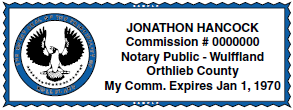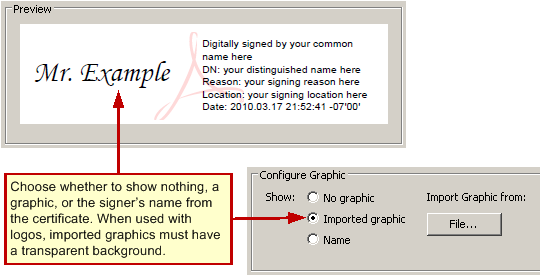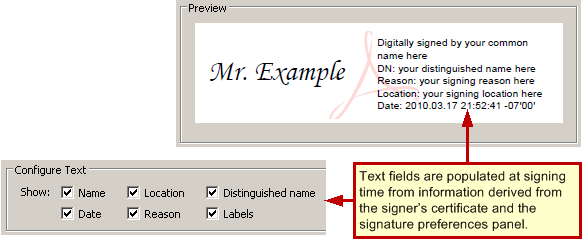How Do I Change My Electronic Signature In Adobe
Custom Signature Appearances¶
Personalized signature appearances allow you to provide boosted information nearly the signer, affiliations, or company. Home users often modify the default appearance as a affair of personal taste, while enterprise users are sometimes provided with a company-specific style and logo. All appearance information is stored in the appearances.acrodata file at %USER%\Application Data\Adobe\Acrobat\(version)\Security .
Every aspect of the visible appearance is subject area to customization, and the options range from using logos, a replica of your handwritten signature, photos, images, and text. A typical appearance consists of three customizable components:

-
Signature: A graphic that identifies the signer on the left-manus side of the appearance, such equally a photo or scanned signatures. Transparent backgrounds allow a watermark to be visible in the underlying layer.
-
Signature details: Signature data that appears to the right of the signature.
-
Watermark or logo: An epitome that appears backside the signature. The default is the PDF logo.
Y'all can create whatsoever number of appearances ahead of time for later apply, and the signing workflow allows you to select one from your library of appearances. Even so, you can besides select the default advent created from your name or create one on-the-fly at signing fourth dimension.

When you lot sign a PDF file, the appearance becomes office of the signed document. Information technology is not function of the actual, hashed signature.

Settings file locations¶
Some digital signature and security data is stored in .acrodata files, and the appearances.acrodata file is 1 of iv such files:
appearances.acrodata: Stores signature appearances. Unless there is a shared company appearance, exercise not use this file.
addressbook.acrodata: Populates the Trusted Identity Manager with document data. This file can be used to distribute a trust anchor for signature validation.
directories.acrodata: Populates the directory server list in the Security Settings Console. This file can be used to configure connections to an LDAP server used equally a certificate repository.
security-policy.acrodata: Populates the security policy listing in the Security Policy Manager. This file can be used to distribute common document security policies.
The exact path to these files vary by application, version, platform, and user. For example:
Windows:
C:\Documents and Settings\(user name)\Application Data\Adobe\Acrobat\(version)\SecurityWindows 7 and later:
C:\Users\(user name)\AppData\Roaming\Adobe\Acrobat\(version)\SecurityMacintosh:
/Users/(user proper noun)/Library/Application Support/Adobe/Acrobat/(version)/Security
What is an acrodata file?¶
An acrodata file is a PDF file. Like any PDF file it's composed of a header, a bunch of objects that comprise stings and streams (in this case the streams are the advent images), a cross reference table, and a trailer. If you alter the extension to PDF and open the file in Acrobat, you'll see each custom image on its own page; however, all you'll run across are the pictures. By using a text editor, you lot tin see other information that helps define the custom signature advent. For example, <Reason true> <Location false> and other $.25 and pieces that define the advent.
The file is loaded when it's needed rather than on launch. For example, when user invokes the New(or Edit) signature appearances console under Preferences and when the Sign Document dialog is called. It's at that time that the PPKlite plug-in looks in the user's Security binder for the file, and if information technology's there, loads the appearance list then the user can select ane to edit or utilise.
At signing time, the signature appearance is written into the PDF file and saved then that information technology gets signed along with all of the previously existing data. If yous've chosen a custom advent, that object was copied from the acrodata file and used to help create the signature object in the signed PDF file.
For details nigh deploying custom advent files for your enterprise, see www.adobe.com/become/acrobatwizard.
Customizing an Appearance¶
Users generally customize i or more signature appearances and store them for later apply. Available signatures are listed in the advent panel at signing time.
To customize a new signature appearance:
-
Cull Edit > Preferences (Windows) or Acrobat > Preferences (Macintosh).
-
Choose in the left-hand list:
-
10.x and earlier: Security and in the Appearance console, choose New or Edit.
-
eleven.x: Signatures > Cosmos and Advent > More, and in the Appearance panel, choose New or Edit.
-

-
Configure the signature appearance Title: Whatsoever title used to identify the appearance. These are useful for identifying which appearance to use for particular workflows.

-
Set the graphic options in the Configure Graphic panel:
-
No graphic: No graphic is used.
-
Imported graphic: Cull File > Browse, select a file and choose OK.
-
Proper name: Your text extracted from the signing certificate.
-

-
Set the text fields to display in the advent in the Configure Text panel:
-
Proper name: The proper noun associated with the certificate.
-
Date: The date signed. Signature appearances can only display local (computer) time, and it will likely differ from that in the Date/Fourth dimension tab on the Signature Backdrop dialog when a timestamp server is used.
-
Location: The location associated with the identity configured in Acrobat.
-
Reason: The reason for signing.
-
Distinguished name: A name with details such as country, arrangement, organizational unit, and so on.
-
Labels: A characterization for each of the items above. For example, Reason.
-

-
Logo: The logo or graphic used as a background watermark. The default watermark is the Adobe PDF logo. Your watermark will be shared automatically in all of your signature appearances.

-
Prepare the text direction and character set in the Text Properties panel:
-
Text Management: Choose a management advisable for the signer'due south linguistic communication.
-
Digits: If languages are installed that utilise digits other than 1234567890, the drib-down listing will be populated with alternate choices. Choose a digit gear up advisable for the signer's linguistic communication.
-
-
Choose OK.

Changing the watermark¶
A watermark is a partially transparent graphic that appears "behind" a signature. By default, the watermark is the Adobe PDF logo. Line (vector) art that is elementary and unobtrusive often works best.
-
Import a logo or create a new one in a program such every bit Adobe Illustrator.
-
Illustrator instructions: Prepare a low transparency level and flatten the transparency:
-
Select all and group the objects if there is more than 1.
-
Choose Window > Transparency and move the slider to some low value such as 20%.
-
Choose Object > Flatten Transparency. Leaving the Raster/Vector balance at 100%.
-
Save the file equally a PDF.
-
-
Open the PDF file in Acrobat.
-
Crop the page and remove white infinite (The method varies across production versions).
-
Save the file as SignatureLogo.pdf in:
-
Windows:
C:\Documents and Settings\(user name)\Application Information\Adobe\Acrobat\(version)\Security -
Windows 7/Vista:
C:\Users\(user proper noun)\AppData\Roaming\Adobe\Acrobat\(version)\Security -
Macintosh:
/Users/(user name)/Library/Application Back up\Adobe/Acrobat/(version)/Security
-
Using handwritten signatures¶
You can use your handwritten signature as the graphic displayed by your signature appearance as follows:
-
Scan your signature at a relatively high DPI; for instance, 300.
-
Convert the image to vector cartoon.
-
Make the background transparent.
-
Save the prototype in the desired format. Acrobat supports a wide multifariousness of formats.

PDF/A compliance¶
PDF/A is a subset of PDF intended as a file format suitable for the long-term archiving of electronic documents. Appearances in PDF/A-compliant documents must adjust to the following:
-
Embbeded fonts. PDF/A requires font embedding because font metrics and glyph compliments change over fourth dimension. Long term archiving tin non rely on anything non included in the document.
-
Colors should use DeviceRGB when signing RGB/Part docs or else with associated ICC profiles.
Source: https://www.adobe.com/devnet-docs/acrobatetk/tools/DigSigDC/appearances.html
Posted by: blackburncounce.blogspot.com

0 Response to "How Do I Change My Electronic Signature In Adobe"
Post a Comment